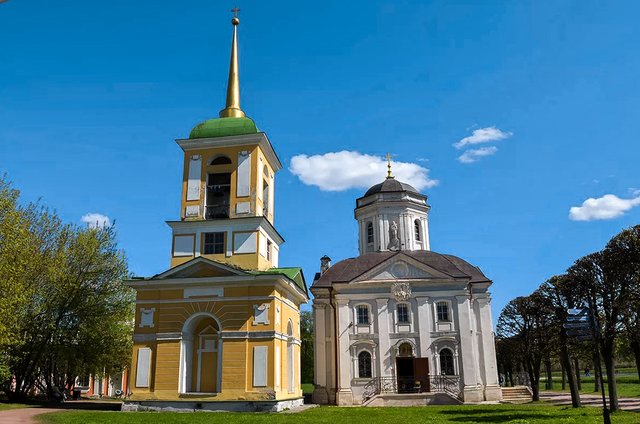Kuskovo - the architectural and artistic ensemble of the 18th century estate of the counts Sheremetev.
Of all the museums, I love manors, summer country house and palaces the most. Because they have large beautiful territories. Several former estates and summer country house of famous people of the Russian Empire have survived in Moscow. One of them - Kuskovo, the summer country house and estate of the Sheremetev family.
.jpg)
There is a large shady park adjacent to Kuskovo and a beautiful pond, where you can go boating in summer. Of course, now the territory of the estate is not as large as it was in tsarist times. But, still quite impressive in size. It is beautiful here at any time of the year. The only negative is that in the cold season marble statues in the park are covered with wooden shields so that they do not deteriorate.
.jpg)
The following buildings have survived to this day:
- the palace, which has preserved the layout and decoration of the interiors with works of Russian and Western European fine and applied art; donative portraits of Russian emperors and several generations of the owners of the estate - the counts Sheremetevs;
- park;
- greenhouse - projects of the serf architect Fyodor Argunov, second half of the 18th century;
- pavilions - Grotto, Hermitage (second half of the 18th century);
- kitchen outbuilding;
- "Italian" (XVIII century) and "Dutch" (XVIII century) houses;
- Church of the All-Merciful Savior (XVIII century);
- Museum of Ceramics (does not have a separate building).
I love wandering around the park and looking at the architecture of Kuskovo. Everything here is so beautiful! The inside is also interesting. But, I like parks more, because there is a lot of space, air, you can be alone with yourself.
Below I will tell you a little about the buildings of Kuskovo.
Kitchen outbuilding
.jpg)
The wing was built in 1755 by the architect F.S. Argunov. It housed Russian and French cuisine, a tablecloth, a coffee shop, a bakery and a pastry shop. The building was built in the same style as the rest of the manor ensemble; its northern and southern facades are decorated with a colonnade and high arched windows. From above, the building is crowned with a balustrade with flowerpots and cartouches (decorative stucco or graphic patterns on the facades in the form of shields, unrolled scrolls or maps).
Church of the All-Merciful Savior (1737-1739) and the bell tower (1792)

The temple is one of the rare monuments of the cult architecture of the Anninsky Baroque - it is quadrangular in plan, rises on a white-stone plinth and ends with a dome with a dome. The planes of the walls are enlivened by pilasters, white-stone sculptures of the apostles are installed in the niches of the drum, and the cross is supported by the figure of an angel with outstretched wings. A relief stands out on the western pediment: the God of hosts sits in the clouds, surrounded by cherubs. The sculptural decoration lends a splendor to the church building, in tune with the architecture of the entertainment residence. The small interior space of the church in the 18th century was richly decorated: a carved iconostasis with old images in frames adorned with precious stones and pearls, gilded royal gates, a count's box and choirs. Once magnificently decorated, with expensive utensils, rich vestments and air, according to legend, embroidered with gold and pearls by the crowned neighbor of the estates - Empress Elizabeth Petrovna - the church retained only late paintings on biblical and evangelical subjects of the mid-19th century. But even to this day, a two-tier chandelier with eighteen candles with figures of seraphim is the true decoration of the temple.
.jpg)
In 1792, as the completion of the entire Sheremetev plan, a wooden bell tower was built, built by the works of serf architects Mironov and Dikushin, - the last significant building in Kuskovo, "closing the circle" in the creation of an architectural ensemble.
Pavilion Grotto (1756-1761 / 75)
.jpg)
One of the most interesting structures in Kuskovo is the Grotto, built in 1756-1761 under the direction of Fyodor Argunov. The stone pavilion in the Rococo style on a three-tiered plinth is lavishly decorated with sculptures in niches, decorations on the pediments, and lion masks over the windows. The walls of the interiors of the Grotto are decorated with shells, stained glass and limestone tuff. As conceived by the architect, the Grotto was supposed to personify the elements of stone and water.
.jpg)
The grotto is the only pavilion in Russia that has retained its unique "grotic" decoration since the 18th century, and is the most exotic among the architectural structures of Kuskovo.
Italian House (1755)
.jpg)
It was built in 1754-1755 with the participation of Yu. I. Kologrivov, who received his architectural education in Rome. In the structure of the estate holidays, the Italian house served as a palace for "small receptions". And, at the same time, in the decoration of the pavilion, the interest in collecting "rarities", rare works of art, characteristic of the 18th century, was reflected, which gave the small palace the originality of a museum.
In the external appearance of the pavilion, one can easily guess the purpose of each of the two floors. The palace character of the second floor interiors finds expression in the architecture of the facade: high window openings, openwork fences of the loggia and balcony, the completion of the cornice with an elegant balustrade. Small rooms on the first floor, visually lower, with square windows, were intended to accommodate "rarities": rare paintings made of beads and colored marble, models of Jerusalem and Bethlehem churches in glass cases, antique sculptures and much more.
.jpg)
In the second part, I will talk about the rest of the buildings in Kuskovo and the interior decoration of the main palace.